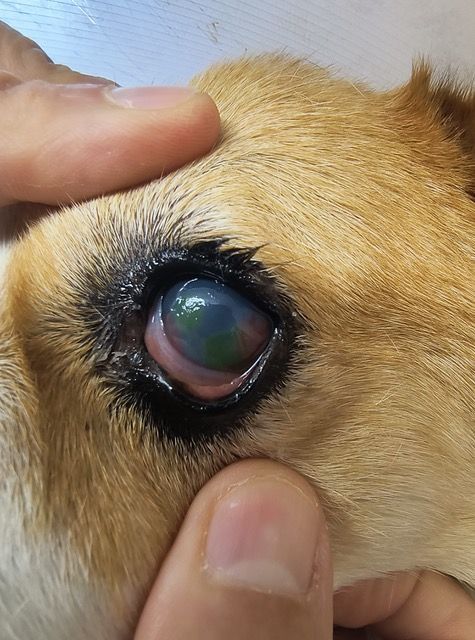Corneal Ulcers

The normal cornea (surface of the eye) is covered by a layer of tissue called the epithelium, similar to a 'skin' over the deeper eye layers. A corneal ulcer is a wound on the surface of the cornea.
WHAT CAUSES A CORNEAL ULCER?
There are many causes of corneal ulcers. Damage to the cornea can occur due to trauma, environmental irritants, or to primary anatomic issues with the eyelids or eyelid function. System disease and tear film abnormalities also can result in deterioration of the corneal health and integrity.
Typical causes of ulcer are:
- Abnormal hairs, eyelashes or foreign bodies irritating the cornea
- Decreased tear production
- Infectious agents
- Immune mediated diseases
- Endocrine disease, including hypothyroidism, Cushing’s disease, and diabetes
- Endothelial cell dystrophy (corneal edema)
- Neurologic deficiency, such as loss of sensory innervation of the cornea
- Radiation therapy near the eye
- Chemical or traumatic injury
HOW IS A CORNEAL ULCER DIAGNOSED?
The most common clinical signs of a corneal ulcer include squinting, redness, cloudiness of the cornea, tearing, or discharge. A special stain called fluorescein can be used to help identify the ulcer on the cornea. Corneal ulcers are characterized according to location,
depth, associated diseases, and cause.
HOW ARE CORNEAL ULCERS TREATED?
Treatment of the ulcer depends on the type and depth of the ulcer. Some corneal ulcers respond to simple application of medications to prevent infection and alleviate pain. Other types of ulcers, particularly those that are very deep sometimes require surgery. There is a specific ulcer called indolent ulcers (superficial chronic corneal epithelial defect aka SCCED). Indolent ulcers are superficial ulcers that tend to heal very slowly unless special techniques are performed, and occasionally require surgery. Very deep ulcers may have a risk of progressing to a corneal rupture and often require surgical intervention to stabilize the cornea.
WHAT IS THE PROGNOSIS FOR A CORNEAL ULCER?
Early identification of corneal pathology, along with proper diagnosis and appropriate treatment plan usually results in the best clinical outcome. During the early stages of medical treatment, it is usual that frequent reevaluation and monitoring of the tissue healing are indicated. Surgical therapy may become necessary if healing is not progressing as anticipated.


